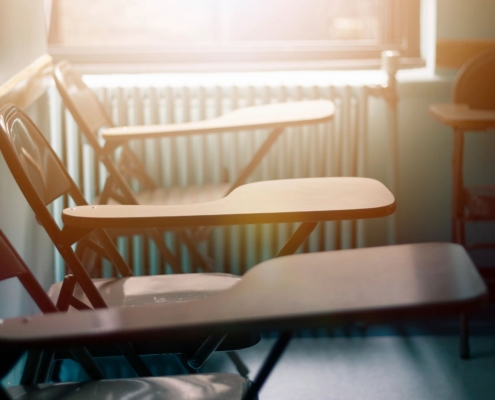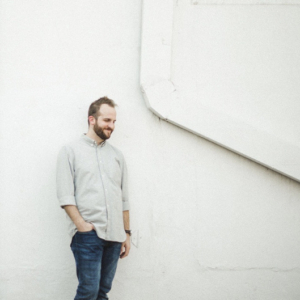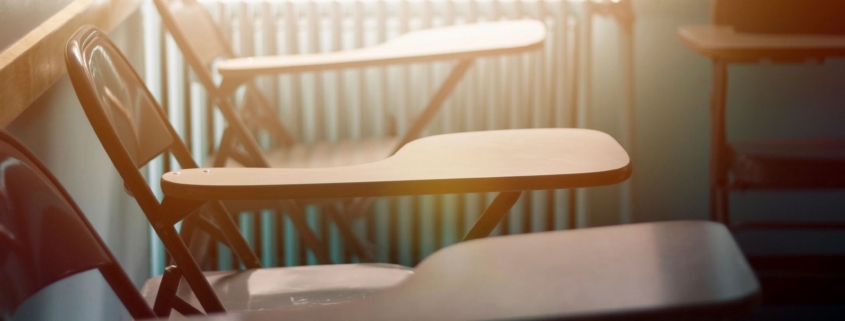Being There: Education in an Emergency
 In my first year of teaching, an entire family came to meet me at our school’s first parent night: mother, father, daughter, and son. They were strikingly tall, both mom and dad my height, and the daughter swiftly approaching. The Samsons (names changed) dressed as if they might be headed to church, or coming from it. In my jeans and school spirit shirt, I felt underdressed. Tamryn, who was a seventh grader at the time, was in my Reading class. Their son was in the second grade.
In my first year of teaching, an entire family came to meet me at our school’s first parent night: mother, father, daughter, and son. They were strikingly tall, both mom and dad my height, and the daughter swiftly approaching. The Samsons (names changed) dressed as if they might be headed to church, or coming from it. In my jeans and school spirit shirt, I felt underdressed. Tamryn, who was a seventh grader at the time, was in my Reading class. Their son was in the second grade.
“If you stick around,” their mother beamed, “you’ll get to teach Zeke.”
I was twenty-two then, and the idea of teaching middle school for another five years seemed distant, a stretch. I had not planned to be a teacher, and my position here was not so much a career choice as a placeholder, a way of putting off grad school and figuring out what I wanted from life. I committed to two years with a teaching program, but beyond that was anyone’s guess. I laughed along with the family, and I brushed the comment aside with a gentle, “We’ll see about that!”
Five years after my first parent night, I did not teach Zeke, but I had Tamryn again. I became the senior English teacher, teaching my first students from the seventh grade. It was a fairytale ending to a five year journey, seeing my kids grow up as I had grown alongside them. They invited me to their homes for graduation parties, where their parents told me I was family.
In March, with few confirmed COVID-19 cases in Texas, our schools closed as we prepared to slow the spread, moving classes entirely online for two months. While this was a necessary precaution, the relational aspect that defines much of teaching for me all but disappeared. Federal and state officials sent directives: continue to educate students online, or risk losing funding. I directed a capstone project where students learn about potential future careers with field experience. How could they complete this when everything closed? Instead of our government having grace, districts—from teachers to students, principals to coordinators—were told to do our best, or else. Having never prepared for this kind of emergency, we were not so much educating students at the highest level as we were scrambling to contain a fire.
After two years of work to prepare my AP students for their exam, I still wanted them to have a fair chance at passing the test, which had been reduced from three essays and many multiple choice questions to a single essay, one attempt at earning college credit. From home, students would have exactly forty-five minutes to read and analyze a passage. I saw teachers on Facebook saying this was too easy, and I logged off, angry. In our school’s history, only one student previously passed the exam: the year before, one of my original kids. My classes worked tirelessly to prove that we could be a school with a rigorous honors English program. But now I knew some were sharing computers with their siblings, on the same Internet connection as their parents, also working from home. Students worked to not lose the gains they had made, even as they emailed me about their anxiety and fear of fumbling the exam. Each message reminded me that this test carried both hope and dread for students, and I responded with encouraging emails, telling them that I was proud of them regardless of the results. They had one shot to prove themselves, in a narrow window. Two of them passed—another landmark for our campus—but I knew more would have in different circumstances.
In the midst of all of this, I sent encouraging comments to my kids, apologetic for asking them to be productive during a pandemic. “I am here to celebrate you and cheer you on, no matter what,” I wrote. “Please know that I am not docking you for making an effort. I see it.” They did what was necessary to pass their final high school courses, as prom, senior week, and graduation were all eventually and inevitably canceled or postponed. “This is unfair,” they said. I agreed, but we had to move forward and check boxes, as if time was not standing still. I spent most of my time filling out a spreadsheet with information on learning engagement, trying to contact students who seemed unreachable. Both students and teachers were ready to check out for the year, and I wondered what the point was in finishing haphazardly. Whatever this was, it was not really learning.
* * *
Then, in September, educators across various states were deemed essential workers, putting their and their families’ health at risk to be present for students. It is hard to know what is right: our students’ education is suffering in this environment, but how are we to keep people safe while helping our kids grow? Instead of prioritizing children, we spent the summer watching state governments allow businesses to reopen too soon instead of providing financial relief. Conservative protesters, backed by the president, raged against the lockdowns as if their personal freedoms were at stake. I worried about my students, who would endure another year of trying to learn through a pandemic.
As COVID-19 spreads and numbers spike again in over forty states, there is a renewed push to send remote learners back to schools amidst rising numbers of failing students. Several districts announced that they now only offer in-person learning, forcing families to send their students to campus or enroll in a different school. The choice as presented to us is this: either students learn in person, or they fail. In the false dichotomy created by a lack of moral leadership, students can either risk contracting and spreading the virus while passing their classes at school, or stay relatively safe from the virus while failing at home. Touting low transmission rates in schools, state and local officials ignore that the spread may currently be low because more than half of 5.5 million Texas public school students are currently learning from home, allowing some measure of distancing in classrooms and hallways. Send everyone back, and those rates could explode. Not to mention that every time a student or teacher contracts the virus, those they expose must quarantine for at least fourteen days, meaning that many children will have to learn from home at some point, by choice or force.
I am not saying that learning from home is ideal or best. But this? Watching the number of deaths in the nation creep over 230,000 while Texas reopens restaurants and bars? While people refuse to wear masks? There is a difference between wanting businesses to make it and demanding more from our leaders. There is a difference between wanting our students to learn and demanding more from people who do not have to bother themselves with creating safe learning environments. In the rush to shuffle students and teachers back to the way things were, we are forgoing conversations about how things could be. Those who quit teaching do not do so lightly, and their reasons for quitting could be prevented under better conditions. Without those difficult and necessary conversations, good teachers who care about students leave the classroom because our hands feel tied instead of freed to do our work well. I am now one of them.
This summer, I decided that I still wanted to serve students, but I needed to take steps to protect my mental and physical health. I left the classroom, but pangs of guilt hit me at various times throughout the summer. I felt like I was abandoning my post, surrendering my station, saving myself while the ship sank. But there is more to me than my job. There is a person to care for, who can only care for others by doing the same for himself.
Not only that, but I could read the writing on the whiteboard: forty-four percent of teachers leave the classroom within five years. I had taught for five, with two years of grad school in between. Ask any teacher who quits and you’ll hear similar answers: low pay, high workload, unjust conditions for vulnerable populations, the seeming lack of connection between state standards and true learning. Those frustrations have only grown with new expectations for teachers who must toggle between teaching in-person and remote learners. As the nation struggles to get and keep teachers in classrooms, and experts predict major backslides in student learning, we keep trying to plug a wound instead of finding a cure, preventing the initial injury. Education is in an emergency state, but COVID-19 did not start that: it is only exacerbating problems that were always there.
* * *
Now it has been seven years since meeting Tamryn’s family, and I am almost thirty. I am still at the same school, and I am entering my eighth year of education in a role where I oversee several special programs, including acting as the liaison between our campus and the local college where our students take dual credit courses. Zeke, now a freshman, is one of those students. I called his mother to ask how he was doing.
“Oh, Mr. Taylor, I am so glad to hear your voice,” she said.
I blushed, though she could not see my face. “Do you remember when you said that if I stuck around I would have Zeke?” I asked.
“I do,” Mrs. Samson said. “You have no idea what it means to see a person be there for our children for this long.”
It was true, I thought, humbled by her kindness. I was just a kid when I started here.
“How’s Zeke?” I asked.
“This has been hard,” she said, her tone dipping. “He’s always been a good student, but this is all too much.”
My heart ached. Students—still children, even if we have known them forever—are expected to charge ahead, to navigate their difficult teenage years while a pandemic rages. Seniors feel cheated, a time in their lives when they should be able to reflect and feel proud of making it this far instead of struggling to get by. Freshmen feel like their transition to high school is starting all wrong. A mother told me that her daughter struggles to focus at home but is afraid to leave the house for fear of contracting or spreading the virus. While the nation seems to be giving up on slowing the spread, our kids are still trying to do their homework, learning how to navigate their emotional and mental development through an unprecedented situation. While they should be given space to learn how to just be, they feel they cannot become themselves until this finally passes.
“I agree, Mrs. Samson,” I replied. “This is all very overwhelming.”
“It kind of feels like we’re underwater,” she said, “and we have to keep swimming and praying that we will reach the surface again.”
Her image was especially apt. We swim in anticipation of breathing the air again. We don’t know when that day will be. We swim to keep from drowning, even if we don’t know when the surface will reappear. I am still learning that. Mrs. Samson is still learning that. Zeke will have to learn it, time and again. In the meantime we help him, give him the skills to stay afloat and reach shore. What if more people invested in Zeke’s safe arrival?
After thirty minutes, Mrs. Samson realized how long we had been talking. “Oh, I’m so sorry,” she apologized. “I know you have more pressing things to do than listen to me vent.”
It was the middle of a school day. I looked at my to-do list, the different tasks that I needed to accomplish before 4pm. I had not noticed how much time had passed, but it did not matter. My role is to serve families, in or out of the classroom. “No, Mrs. Samson,” I countered. “I am here to support you in any way that I can, even if I don’t have all of the answers.”
“Oh, you do, you do support us,” she said. “I want you to know that I appreciate that you are there for both of our children, and I pray for you daily, that you may have the strength and wisdom to do your job, and that you will be blessed in life.”
I was on the verge of tears, and I remembered the day that I met the Samsons, how young Zeke and Tamryn were. Yes, how young I was, and still am. I’m still here, I thought. I’m really still here. Was it Mrs. Samson’s prayers that carried me all along? “Thank you,” I said. “Your prayers mean a lot to me.”
We said goodbye after Mrs. Samson showered me with more blessings. I sat in my office, too quiet now. I picked up the phone and called another family, the only way I knew how to be here, right now, in this moment, while an alarm sounds, just waiting to be heard.
 Ben Lewellyn-Taylor lives in Dallas, TX with his spouse Meg. He is an MFA student in Antioch University’s low-residency program, where he also works on the Lunch Ticket staff. Ben co-hosts Book Cult with Cristina Rodriguez. His work appears on The Adroit Journal, New South, No Contact Mag, and FreezeRay Poetry, among others. He can be found on Twitter @blewellyntaylor.
Ben Lewellyn-Taylor lives in Dallas, TX with his spouse Meg. He is an MFA student in Antioch University’s low-residency program, where he also works on the Lunch Ticket staff. Ben co-hosts Book Cult with Cristina Rodriguez. His work appears on The Adroit Journal, New South, No Contact Mag, and FreezeRay Poetry, among others. He can be found on Twitter @blewellyntaylor.





